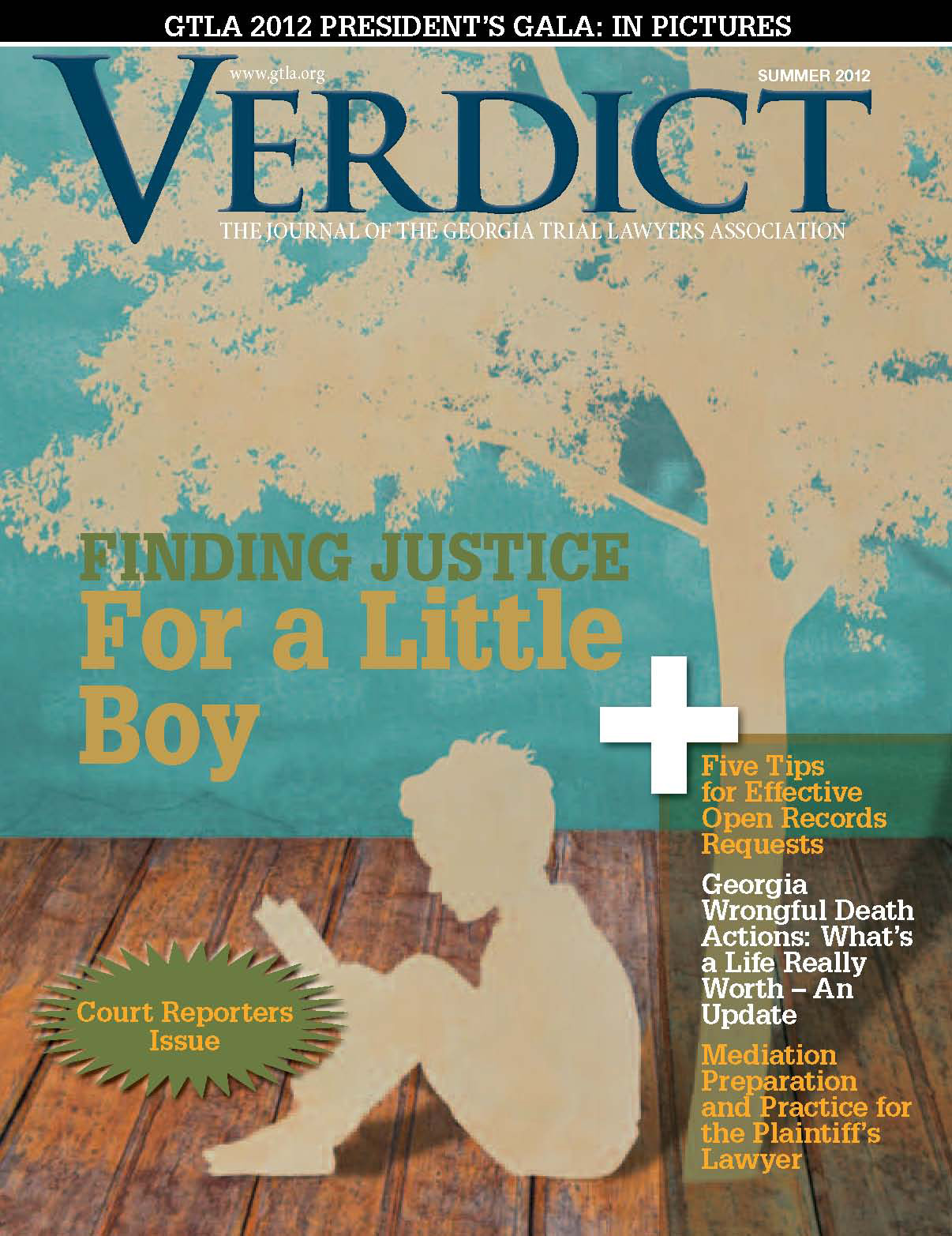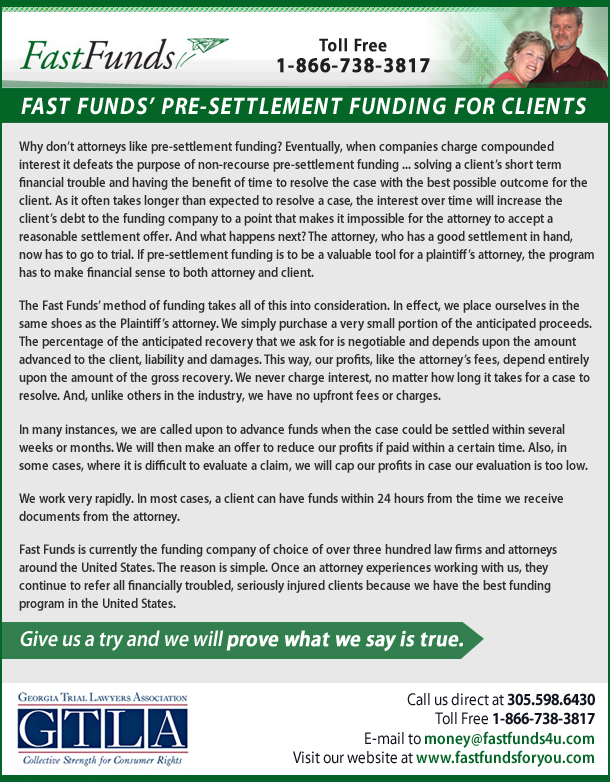GTLA UPDATE
Georgia Trial Lawyers Association
Medical Matters in Apportioned Settlements
 By Alice Adams
By Alice Adams
Imagine this scenario: An attorney has a pending 15 million dollar settlement offer for his clients1. They are four college athletes whose bus was struck by an 18-wheeler, and two are deceased. The offer stipulates that the funds be apportioned to each plaintiff and that the settlement resolve all claims of the parties. These assessments must be submitted within the next two weeks. How will he meet this deadline?

The attorney in this case called in a legal nurse consultant (LNC) to perform medical analysis of injuries, pain and suffering, and residuals, and presented the data in a way that all could understand and agree upon. In such an emotionally charged setting, the safest and most defensible position is to objectively present each client’s injury or fatality. Every scenario is unique, but this could easily mirror your next personal injury case.
Client Number One
Client number one (Roy) was a young man of 22 years old whose injuries were objectively the least severe. They included one uncomplicated lumbar fracture and a wrist strain, but no head injury or internal damages. Nonetheless, the LNC would advise you that Roy may demand a disproportionate amount of compensation for his pain and suffering. She senses this because his pain complaints are increasing over time despite complete healing, and as he proceeds to a second, third and fourth opinion on his ability to play ball again, he relates ever more distress. A worried mother encourages this behavior, but why? The review of past medical and academic records reveals that he is an anxious young man who self-medicates with marijuana and Valium, has two DUIs, was a mediocre student and was often on the bench. Simply put, his prospects prior to the accident were never assured. He may be unconsciously using his injury to justify his continued poor performance.
With Roy’s urgent complaints, his mother’s anxiety, and without knowing his medical history and objective findings, one could easily overestimate future medical costs. To most, a non-displaced T12 compression fracture with 15 degree step-off sounds like lasting damage. Orthopedic nursing experience and a research of the literature confirms that this vertebra is healed, and Roy has no objective limitations. This puts Roy’s demands into perspective.
Client Number Two
Client number two (Barry) probably died upon impact. Propelled through the windshield and down a 60-foot embankment, he landed head first on a large pile of rocks. Barry was pronounced dead at the scene, and his family is devastated by the thought of his last moments spent alone and in pain. This haunting memory is the impetus for a claim of Barry’s pain and suffering as well as their own.
An autopsy revealed massive head trauma with multiple skull fractures. His aorta, the largest artery in the body, was cleanly dissected, with more than half his blood volume compressing his lungs. Evaluation of this case includes several considerations.
* Did Barry die upon impact or did he suffer in the 15 minutes it took EMT to find him? The autopsy report revealed three skull fractures, the most severe at the base of the brain in the area that controls basic life function. The Medical Examiner believes Barry’s jaw struck first, forcing the head backwards. When the LNC researches the mechanics of this shearing injury and speaks informally with a neurologist, all information suggests that he was instantly unconscious and did not suffer.
* But absent his head injury, would Barry have died from the severed aorta; how long does it take to bleed to death internally? Statistics indicate that death would have occurred within 1 ½ to 2 minutes from a combination of compressed lungs and blood loss. With his aorta completely dissected, every beat of Roy’s heart was literally killing him. A conversation with a cardiothoracic surgeon supported this opinion, and he was willing to testify if needed.
The neurological and cardiovascular findings support immediate unconsciousness and rapid demise, and his friends say that he was asleep at the time of the accident. Ostensibly, this analysis has addressed the issue of pain and suffering.
* But what about the time between sleeping and impact? Was he jolted awake? Was there a time when Barry was aware of impending disaster? This question was central in the controversial Maryland ruling on a 2006 drowning of a five year old. The jury’s recommendation to remove non-economic caps and award the parents additional money for the child’s pain and suffering made this an important legal case. The trial judge imposed the cap, however, and did not allow the jury to consider suffering, simply because the drowning was unwitnessed. No one heard the tree fall. The appellate court reversed, but the Court of Special Appeals upheld the ruling. The court of public opinion and anguished parents disagreed. No one observed Barry in the chaos to know if he was frightened and aware in those seconds between the initial crash and his final impact, but the possibility must be considered in the award to his grief-stricken parents.
Client Number Three
Client number three (Jason) suffered massive head trauma and internal injuries. He never regained consciousness and died six days after the accident. The central question here is whether or not he was aware of pain or fear during those six days. Did he suffer, and what should an attorney look for to answer this question? The LNC will scrutinize the nursing and neurology notes for any information that may quantify consciousness or qualify pain and will also look at injuries.
* Jason’s left lung was punctured and collapsed; his lungs required bilateral chest tubes for re-expansion.
* His spleen was ruptured and had to be removed, compromising his ability to fight infection. Despite precautions, he became septic over the next few days.
* His abdominal wall was open at the scene (a "dirty wound"), and surgeons could not close his incision without fostering another infection. Instead, they sutured a sterile plastic covering to the edges of the wound, allowing visualization and irrigation with antibiotics.
* Jason’s head injury was not a simple blood clot in one area that could be surgically removed. His entire brain was diffusely swollen.
The issue of unconsciousness is not clear cut, but it is the central question. Neurologists measure level of awareness with the 15-point Glasgow Coma Scale, or GCS. Jason’s GCS fluctuated from 3 to 6. In this range, patients are considered comatose, with no meaningful response and no voluntary activities. Responses to pain are reflexive, not purposeful, and are described as decerebrate and decorticate posturing. It would take time and money to describe these critical conditions in detail. Instead, the LNC can locate pictograms and create .jpgs from actual chart diagrams to describe the critical conditions for the attorney.
There were several tools used to communicate complex concepts, including:
1. Decorticate & decerebrate posturing example
2. Illustration showing how a chest tube allows a deflated lung to expand
3. Resident’s drawing of open abdomen and invasive tubes
This case requires researching the Glasgow Coma Scale, assessing trauma resuscitation, reviewing CT scans, intracranial pressures, effects of concentrated saline in the body and numerous other technical matters. An attorney typically does not require or even want a detailed description of all this, but he does want to know the impact of the injuries.
To complicate matters further, the LNC tells you that likely none of Jason’s injuries were fatal but for a medical resident’s error. Here is what happened:
The medical resident ordered a hypertonic (concentrated) IV saline solution. Hypertonic fluids have more particles than the body's water. They pull water back into circulation from the brain cells, "drawing" fluid from a swollen brain. This delicate process requires close monitoring of blood sodium levels. The levels were drawn and called to the resident, but he allowed the solution to run 18 hours longer than it should have, with the end result being kidney failure and pulmonary edema. So in addition to the trucking company, there may be secondary liability of the hospital, an issue you must address before signing a general release.
Client Number Four
The largest award will clearly go to client number 4, 22-year-old Bryan. This boy also suffered a severe traumatic brain injury (TBI) but with a protracted recovery. His injury resulted in right-sided weakness and limb contractures on the left (elbow, knee and ankle locked into 45-degree positions). His "lost chance" was a career as a nurse anesthesthetist. Despite a remarkable recovery (now walks with a cane, passed a driver’s test, is able to take one college course per semester with a scribe) he will never realize his career goals. He will need yearly neuropsychological evaluations, home modifications, personal assistants, psychotherapy, physical therapy and other considerations. The lives of his parents will be forever altered by his reliance upon them, and this is a non-economic consequence of the accident.
The LNC in this scenario analyzed these four cases with thousands of pages of medical records, photographs and autopsy reports during the first week, leaving the second week for the attorney to formulate a fair financial allocation. During that first week, he could attend to other cases, knowing that he would be contacted if questions arose. In the end, no expert witnesses were needed, and the maximum payout was awarded to each client.
For a field that is almost 30 years old, the definition of a legal nurse consultant is not always clear, even to the attorneys who hire them. The confidential nature of an LNC’s work product means that opposing counsel never knows when an LNC has written a medical questionnaire, prepared a witness for deposition, assisted with a plaintiff’s response to interrogatory or researched medical archives. Opposing counsel only sees a well-prepared adversary.
In other realms, controverted workers’ compensation cases can be successfully managed when nursing analysis by an LNC provides the "missing link" in the medical chain of causation/exacerbation. Determining medical cost projections, life care plans, and Medicare set-asides are also important contributions to mediation and settlement.
Attorneys cannot erase an accident or the resulting change in a client’s life, but they can maximize compensation by not missing important medical data or being surprised by opposing counsel. A legal nurse consultant is a medical professional that can simplify complex cases and free up time to write briefs, research case law, prepare for trial and do all the other things that only attorneys can do.
About the Author: Alice Adams is an independent legal nurse consultant and owner of Medical Case Consultants, LLC in Atlanta. Her nursing background is in critical care, head trauma and psychological assessment. Her practice is primarily personal injury, medical malpractice and workers compensation.
She enjoys presenting webinars and seminars and is the outgoing president of the Atlanta chapter AALNC. Alice is a contributing author to the American Association of Legal Nurse Consultants’ 2011 textbook: Growing Your Practice: Resources, Tools & Reports, two other books already in print, and a third slated for early 2012 release. She can be reached at 404.771.5155, alice@alicemadams.com, or through her website at www.alicemadams. This redacted article was written with the review and consent of the lead attorney in the case.
Footnotes:
1. The attorney has complied with Bar Rule 1.7, Conflicts of Interest and Formal Advisory Opinion No. 03-2, Confidentiality with Jointly Represented Clients.
Summer 2012 Verdict Sneak Peak:

Finding Justice for a Little Boy
How a persistent team of lawyers pursued a case for eight years, in hopes of finding justice for a child abuse victim.
Mediation Preparation and Practice for the Plaintiff's Lawyer
Lessons for plaintiff's lawyers on mediation preparation, including tips on how to prepare the client for the process.
GTLA 2012 President’s Gala: In Pictures
A special 2-page photo spread on the GTLA 2012 President's Gala.
Sharpening the Sword: Five Tips for Effective Open Records Requests
With the recent revisions to the Georgia Open Records Act in mind, this article offers tips for making sure your request is fulfilled.
Tire Tips: 10 Ways to Avoid Blowing Your Tire Case
These tips will help you to examine the evidence after an accident so that your client has the best possible chance of justice.
+ Much more!
